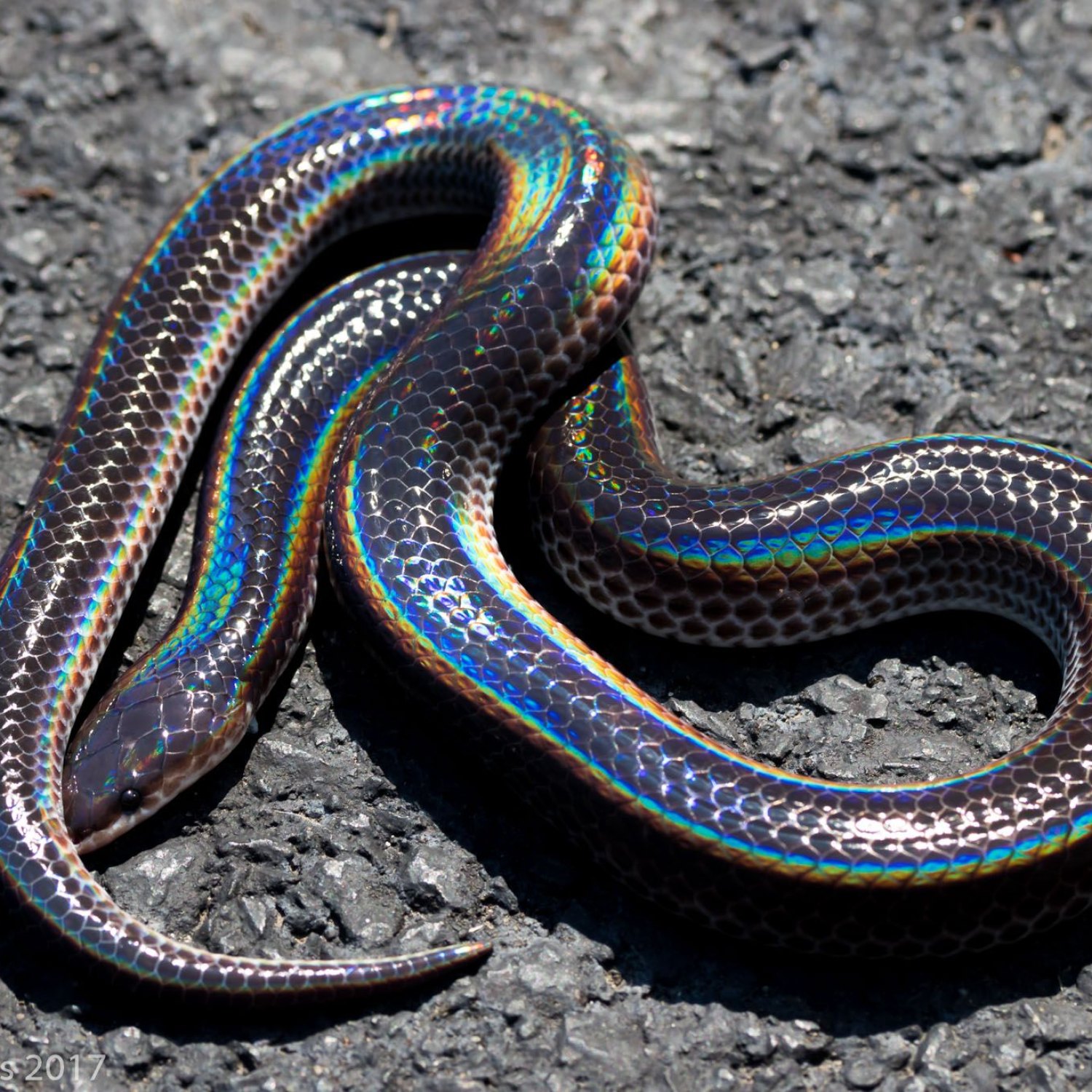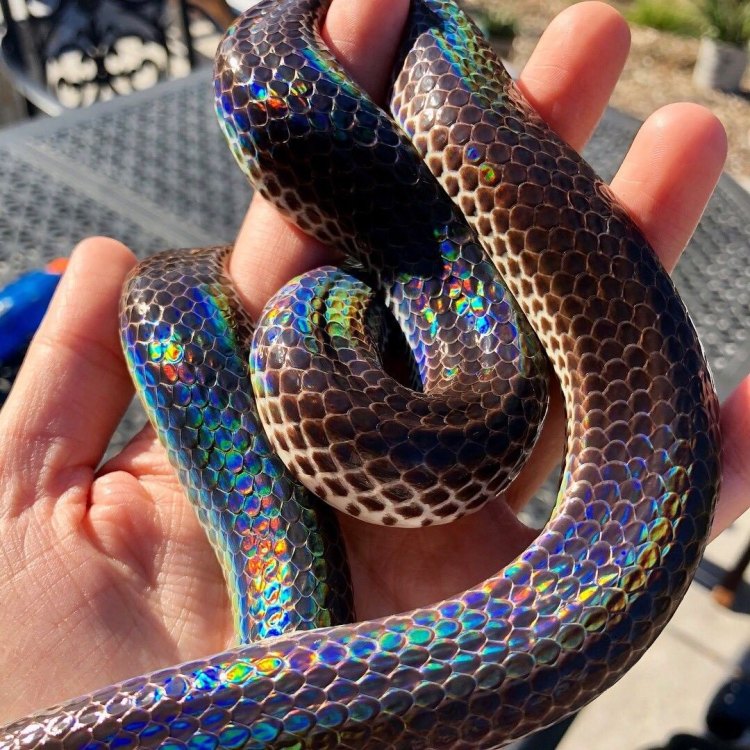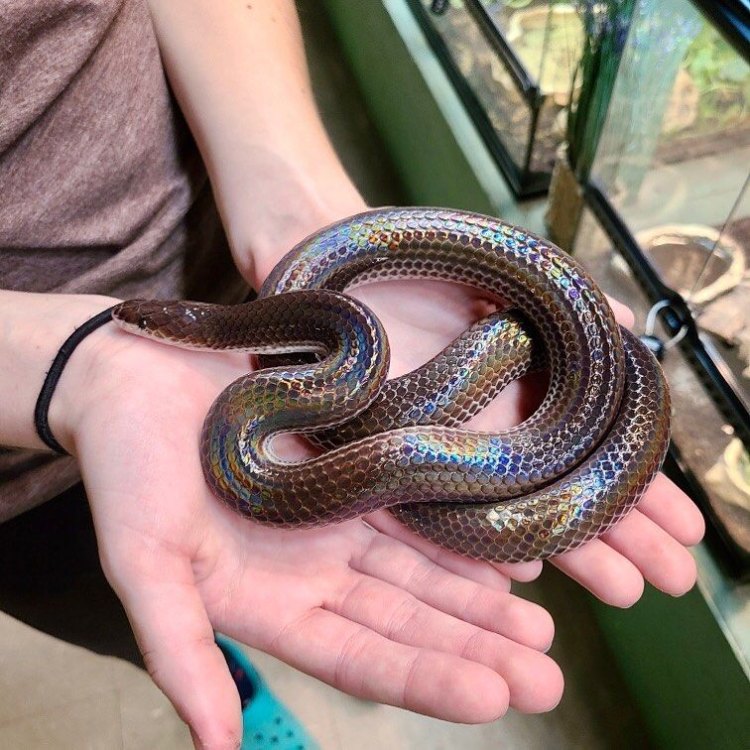
Sunbeam Snake
Average length of 1 meter (3.3 feet), but can reach up to 1.5 meters (5 feet)
The Sunbeam Snake, a fascinating creature found in gardens and forests, belongs to the Xenopeltidae family. These ground-dwelling animals range from 1 to 1.5 meters in length, making them the perfect size for exploring and hunting. With their slender and cylindrical body shape, they are masters of maneuverability and can move swiftly through their natural habitat. Keep an eye out for these stunning snakes next time you're exploring the great outdoors!
Animal Details Summary:
Common Name: Sunbeam Snake
Kingdom: Animalia
Habitat: Tropical rainforests, grasslands, and farmlands
The Mesmerizing Sunbeam Snake: The Jewel of Southeast Asia's Rainforests
Located in the lush tropical rainforests of Southeast Asia lies a stunning creature that has captured the attention of many with its unique characteristics and mesmerizing appearance. Meet the sunbeam snake, also known as Xenopeltis unicolor, a ground-dwelling reptile that inhabits countries such as Indonesia, Thailand, Myanmar, Cambodia, Laos, Vietnam, and Malaysia. Its name derived from the Greek words "xenos" meaning strange and "peltis" meaning shield, this snake's beauty and mystery have stirred up curiosity and fascination amongst nature lovers and scientists alike.Classified as a Reptile, Belonging to Family Xenopeltidae
Like its distant cousins, the sunbeam snake belongs to the kingdom Animalia and phylum Chordata. However, what sets it apart is its classification as a reptile under the class Reptilia. This classification means that the sunbeam snake is cold-blooded, has a scaled skin, and breathes through lungs. It also lays eggs and has a three-chambered heart, which is another defining characteristic of reptiles.Within the order Squamata, the sunbeam snake belongs to the family Xenopeltidae, making it a unique species of its own. Unlike other members of this family, which are mostly burrowing snakes, the sunbeam snake is primarily ground-dwelling, venturing out only to hunt for food.
A Habitat as Diverse and Beautiful as its Appearance
The sunbeam snake has a vast and diverse habitat, making it a versatile and adaptable species. It is mostly found in tropical rainforests, where it can camouflage easily amidst the dense foliage. However, it also has a presence in grasslands and farmlands, making it a common site for farmers who often encounter these snakes in their fields Salmon.This species' ability to thrive in various habitats is impressive, especially considering the rapid destruction of its natural environment due to human activities. Many conservation efforts have been put in place to protect the sunbeam snake and ensure that future generations can admire its beauty.
The Carnivorous Feeding Method of the Sunbeam Snake
As a carnivorous species, the sunbeam snake has a varied diet that includes birds, small mammals, and lizards. Its shiny black scales, which are its most striking feature, allow it to blend seamlessly with its surroundings while hunting for prey. However, once it captures its victim, the sunbeam snake will quickly reveal its true colors.Its strong jaws and sharp teeth are used to subdue its prey, and the snake kills its victim through constriction. Once the prey is dead, the sunbeam snake will swallow it whole, using its flexible spine to expand and stretch its body to accommodate larger prey. This ability to eat creatures much larger than itself is impressive, making the sunbeam snake a formidable predator in its habitat.
A Master of Coloration and Camouflage
One of the sunbeam snake's most prominent features is its shiny, iridescent black scales on the dorsal surface. These scales give off a stunning reflection in sunlight, creating a hypnotizing rainbow-like effect that has earned this species its nickname "sunbeam snake."The dorsal scales' arrangement also aids in camouflage, as they reflect the colors of their surroundings, allowing the snake to blend effortlessly into its environment. This impressive coloration is not only beautiful but also serves as a defense mechanism against predators, making it difficult for them to spot the snake in the wild.
A Slender and Cylindrical Body Perfect for Maneuvering through its Habitat
The sunbeam snake has a slender and cylindrical body, which is ideal for maneuvering through its habitat. It allows the snake to slither quickly through the rainforest's dense vegetation, making it an elusive animal even to experienced herpetologists. The sunbeam snake also has a unique way of moving, which is by using its scales to grip onto surfaces and push itself forward.The sunbeam snake's body shape also makes it an excellent climber, allowing it to move with ease along tree branches and trunks. Additionally, its cylindrical body enables it to hide in crevices and burrow underground when danger arises.
The Average Length of the Sunbeam Snake
On average, the sunbeam snake reaches a length of 1 meter (3.3 feet). However, some individuals can grow up to 1.5 meters (5 feet), making them one of the longest snake species in Southeast Asia. It's slender and cylindrical body, combined with its length, makes it an agile hunter, capable of reaching its prey in challenging environments.The Sunbeam Snake – A True Jewel of Southeast Asia
The sunbeam snake is indeed a gem of Southeast Asia's rainforests. Its unique characteristics, striking coloration, and adaptability make it a mesmerizing creature that intrigues both researchers and nature enthusiasts. However, with human activities posing a threat to its habitat, conservation efforts are crucial to ensure that this beautiful snake continues to thrive in the wild.As we continue to discover and learn more about the sunbeam snake, we must also remember the importance of preserving its natural habitat. Only through our collective efforts can we ensure that this jewel of Southeast Asia's rainforests will continue to shine for generations to come.

Sunbeam Snake
Animal Details Sunbeam Snake - Scientific Name: Xenopeltis unicolor
- Category: Animals S
- Scientific Name: Xenopeltis unicolor
- Common Name: Sunbeam Snake
- Kingdom: Animalia
- Phylum: Chordata
- Class: Reptilia
- Order: Squamata
- Family: Xenopeltidae
- Habitat: Tropical rainforests, grasslands, and farmlands
- Feeding Method: Carnivorous
- Geographical Distribution: Southeast Asia
- Country of Origin: Indonesia, Thailand, Myanmar, Cambodia, Laos, Vietnam, and Malaysia
- Location: Ground-dwelling species
- Animal Coloration: Shiny, iridescent black scales on the dorsal surface, with a reddish or purplish hue depending on the light
- Body Shape: Slender and cylindrical
- Length: Average length of 1 meter (3.3 feet), but can reach up to 1.5 meters (5 feet)

Sunbeam Snake
- Adult Size: Medium-sized snake
- Average Lifespan: Unknown in the wild, but individuals in captivity have been recorded to live up to 15 years
- Reproduction: Oviparous (lays eggs)
- Reproductive Behavior: Males engage in combat for the opportunity to mate with a female
- Sound or Call: Does not produce significant vocalizations
- Migration Pattern: Non-migratory
- Social Groups: Solitary
- Behavior: Nocturnal and secretive
- Threats: Habitat loss, illegal wildlife trade
- Conservation Status: Not evaluated by the IUCN Red List
- Impact on Ecosystem: Plays a role in controlling populations of small mammals and other reptiles
- Human Use: Not used for any specific human purposes
- Distinctive Features: Iridescent black scales and shiny appearance
- Interesting Facts: 1. The Sunbeam Snake gets its name from the iridescent reflection of sunlight on its scales, giving it a beam of light appearance. 2. It has a unique defensive behavior of curling its tail over its head, exposing the shiny scales, when threatened. 3. The scales of the Sunbeam Snake are keeled, which gives them a rough texture.
- Predator: Predators of the Sunbeam Snake include larger snakes, birds of prey, and mammals.

Xenopeltis unicolor
The Mysterious Sunbeam Snake: A Perfect Blend of Elegance and Enigma
The world of snakes is filled with a diverse range of species, each with its unique features and characteristics. Among them, the Sunbeam Snake (Xenopeltis unicolor) stands out with its distinctive iridescent black scales and a shiny appearance, earning it the nickname of "The Sunbeam of Asia." This medium-sized snake is a fascinating yet mysterious creature that continues to capture the interest and curiosity of herpetologists and snake enthusiasts.In this article, we will delve into the unique features of the Sunbeam Snake and uncover some interesting facts about this elusive creature PeaceOfAnimals.Com.
Appearance and Size
The Sunbeam Snake is a medium-sized snake, with adults reaching an average length of 3-4 feet. The longest recorded specimen was 5 feet long, making it one of the largest snakes in its family, the Xenopeltidae. It has a slender body with a slightly flattened head, small eyes, and a pointed snout. The neck is narrow and distinct, giving it an elegant appearance.However, what makes the Sunbeam Snake truly stand out is its iridescent scales. These sleek and glossy scales give the snake a unique metallic sheen, reflecting all the colors of the rainbow when exposed to sunlight. This striking feature has given rise to its common name, the Sunbeam Snake.
Lifespan and Reproduction
The average lifespan of Sunbeam Snakes in the wild is still unknown. However, individuals in captivity have been known to live up to 15 years, indicating that they may have a similar lifespan in their natural habitat Smallmouth Bass. As oviparous (egg-laying) creatures, female Sunbeam Snakes lay small clutches of eggs in the leaf litter or under rocks.Reproductive Behavior
Mating in Sunbeam Snakes is a highly competitive affair, with males engaging in combat for the opportunity to mate with a female. This behavior is often observed during the breeding season, which varies depending on the region but is generally between March and May in Southeast Asia.Once mating is successful, the female will lay and incubate her eggs for about two months before hatching. The hatchlings are around 7 inches long and are typically grayish-brown in color, resembling miniature adults.
Behavior and Social Groups
Sunbeam Snakes are primarily solitary creatures and are rarely seen in the wild. They are nocturnal and spend their days hiding under leaves, rocks, or logs. At night, they venture out in search of prey, using their keen sense of smell and their forked tongue to detect their food.When threatened, Sunbeam Snakes have a unique defense mechanism. They will curl their tail over their head, exposing their shiny scales, which can be mistaken for a second head. This behavior is believed to be a way to confuse predators and deter them from attacking.
Threats and Conservation Status
The Sunbeam Snake is facing a decline in population due to habitat loss and illegal wildlife trade. Its habitat, which includes tropical forests and grasslands, is being destroyed at an alarming rate for commercial and agricultural use. Additionally, this snake is also hunted for its skin, which is used in the production of traditional medicine and jewelry.As of now, the Sunbeam Snake has not been evaluated by the International Union for Conservation of Nature (IUCN) Red List. However, it is listed under Appendix II of the Convention on International Trade in Endangered Species of Wild Fauna and Flora (CITES), which regulates and monitors international trade of this species.
Impact on Ecosystem
As with most reptiles, Sunbeam Snakes play a vital role in maintaining a balance in their ecosystem. They are known to control the population of small mammals and reptiles, such as rodents and lizards, which makes them beneficial to farmers. In turn, they also serve as prey for larger predators, such as larger snakes, birds of prey, and mammals. Thus, their presence in the food chain is crucial for the survival of various species.Human Use
Unlike many other snake species, Sunbeam Snakes are not used for any specific human purposes. They are not venomous and do not serve as a food source or a pet. However, their striking appearance has made them popular in the illegal wildlife trade, where they are captured and sold as exotic pets or for their skin.Interesting Facts
1. One of the most distinctive and unique features of the Sunbeam Snake is its iridescent scales. It is due to this that the snake gets its common name, "The Sunbeam of Asia." This shiny appearance is caused by the way light reflects on its scales, giving it a beam of light effect.2. When feeling threatened, Sunbeam Snakes have a unique defensive behavior of curling their tail over their head, exposing their shiny scales. This behavior is believed to be a way to confuse predators and deter them from attacking.
3. The scales of Sunbeam Snakes are keeled, which gives them a rough texture and provides better traction, making them excellent climbers.
Conclusion
The Sunbeam Snake is an enigmatic creature, often elusive and hard to study in the wild. With its distinctive appearance and unique features, this snake continues to capture the interest and curiosity of many. However, the decline in its population is a cause for concern, and conservation efforts must be made to protect this mysterious creature from further harm. Through conservation and education, we can ensure the survival of the Sunbeam Snake and maintain the balance of its ecosystem.

The Mesmerizing Sunbeam Snake: The Jewel of Southeast Asia's Rainforests
Disclaimer: The content provided is for informational purposes only. We cannot guarantee the accuracy of the information on this page 100%. All information provided here may change without prior notice.












